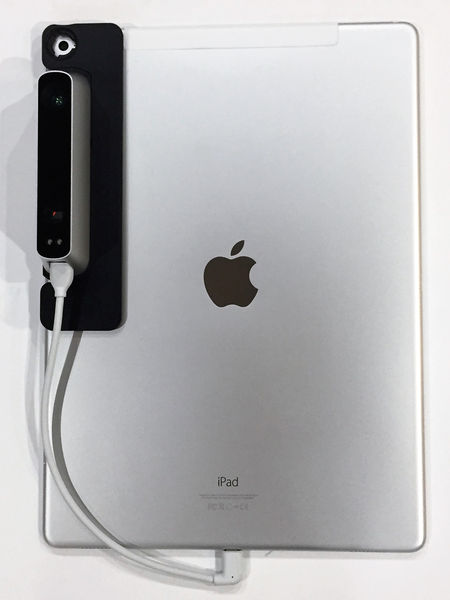
REVIEW – The iPad market share has hovered around 20 to 30% for the past few years. Imagine how different our world and experience would be if each one of those cameras had 3D capture ability. The Structure Sensor is an attachment to the iPad that provides the ability to capture 3D information. Read on to see what I think!
What is it?
The Structure Sensor is an attachment to an iPad, but also works with non-iPad tablets, iPhones, and can be modified to work with standalone applications. It contains two infrared LEDs, an infrared structured light projector, and an infrared camera. The Structure projects a unique infrared pattern of dots out in front of it, and the infrared camera captures the projected pattern as it is reflected off of objects. Apparent variations in the position of the captured dots are interpreted by software to determine the relative position of a captured image. The graphic below, by Paul Kah of the Lappeenranta University of Technology, Department of Mechanical Engineering, illustrates the technique in a cartoon.
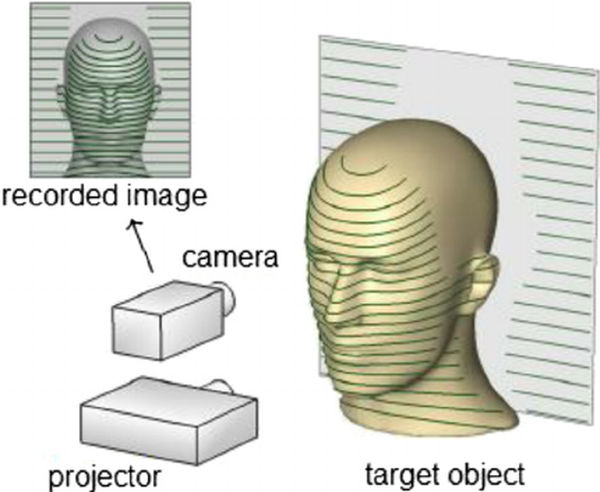
The Structure Sensor uses images from the iPad’s built-in camera, so aligning the Structure sensor up to the built-in camera is critical. The Structure Sensor provides a custom designed mount to ensure alignment. The sensor software also uses the iPad accelerometer, compass, and computing power to generate the 3D images.
What’s in the box?
My employer purchased this device so I didn’t see the box it came in. The following description is from the Structure website:
Structure Sensors purchased directly from the Official Structure Sensor Store will arrive in a gift box, like so:

Structure Sensors purchased from Amazon.com will arrive already assembled, in a new “bento box” style, which doubles as a carrying case for your Structure Sensor, bracket, and cables:

Regardless of where it was purchased, your Structure Sensor should arrive with the following:
- One Structure Sensor
- One Lightning cable
- One Power Adapter
- One magnetic screwdriver
- Eight (8) M1.6 screws
- One user manual
Precision Bracket with Aluminum Latch
The Precision Bracket with Aluminum Latch will arrive in a separate box, like this one:

Precision Brackets with Aluminum Latch for iPad Air 2 and iPad Mini 4 will arrive in a “bento box” style, which doubles as a carrying case for your assembled Structure Sensor, bracket, and cables:

Structure Sensor Bracket For iPad Pro

Your Structure Sensor iPad Pro Bracket should arrive with the following (shown from top to bottom):
- One Bracket Alignment Tool
- One Structure Sensor Base Plate
- One Bracket
This is what the bracket looks like when not attached to the camera:
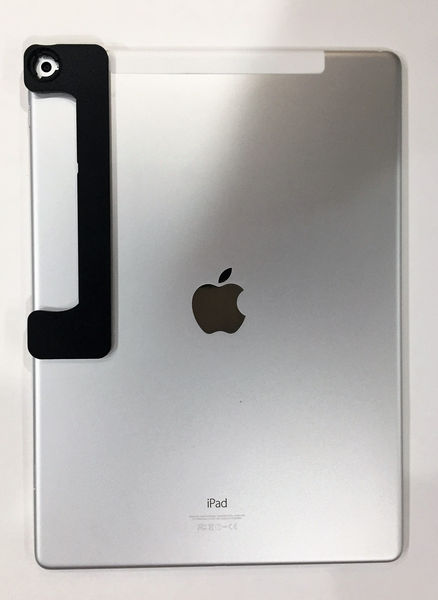
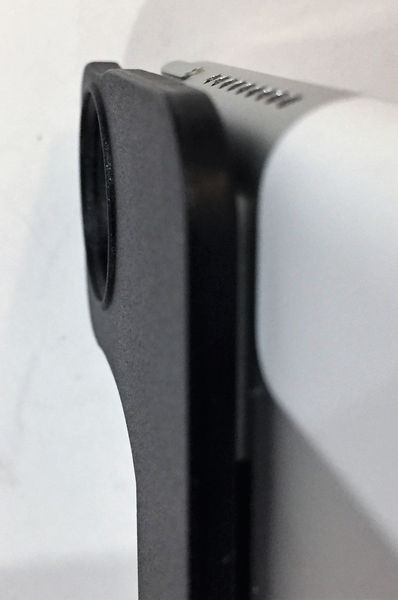
The bracket surrounds the iPad camera so that a specially designed 120-degree lens may be installed for use with some applications. The camera lens may be unusable by other hardware add-ons if the bracket secured with an adhesive is applied to the rear of the iPad.
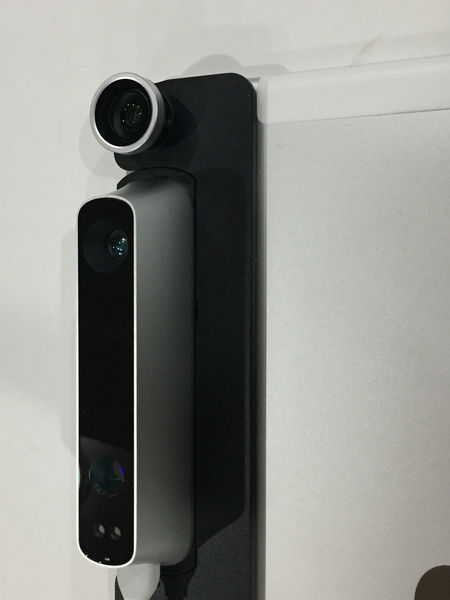

Design and features
The Structure Sensor is an anodized aluminum device with a glass front and a plastic back. The back is designed to fit into or screw onto a bracket that connects it to the iPad. The Structure Sensor has its own internal battery to preserve the battery life of the iPad, The bottom side of the camera has a port for the dedicated AC charger. An LED indicator on the Structure Sensor’s glass face will pulse when your Structure Sensor’s battery is charging. As soon as your battery is completely charged, the LED indicator will be illuminated continuously until the AC charger is disconnected.
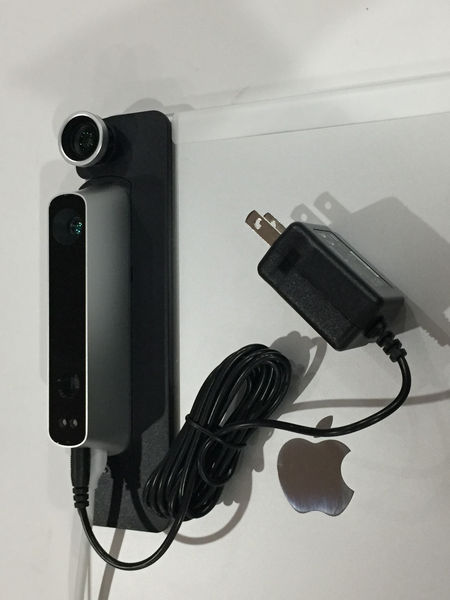
There is also a port for the data cable to lightning adapter cable
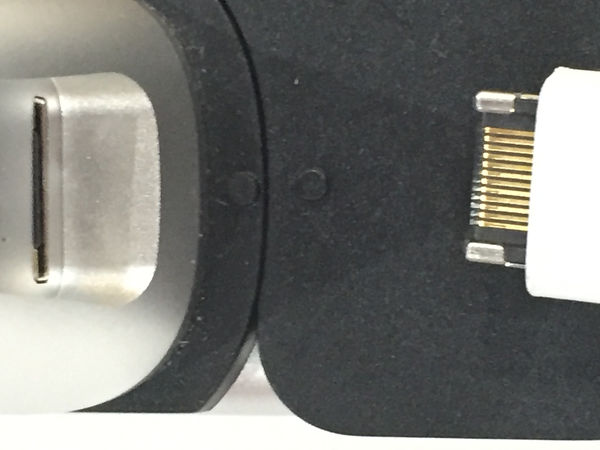
If the Structure Sensor is used with a non-iPad device a separate cable may be purchased that terminates in a USB type-A connector. This cable may also be used with a USB power adapter to charge the Structure Sensor and will charge the battery more quickly than the standard Power Adapter.

When the sensor is latched to the rear of a device and connected with the dedicated data connection to the device it looks like a kludge to repair an inoperable camera. Technically its similar to taping a Microsoft Kinect to the back of the iPad. However, despite its appearances, the bracket and camera are sturdy when attached and function as if the Structure Sensor were an integral part of the tablet.
The biggest feature of the Structure Sensor is that it was designed as a piece of standalone hardware and not a custom attachment for a specific program. Occipital, the makers of the Structure Sensor published an SDK for the hardware very early on. This development philosophy helps establish this hardware as a well-supported attachment to the iPad. There are over 80 apps built for Structure Sensor as of December 2018.
Rapid 3D scanning of objects and people and 3D scanning of interior spaces were the features I used. The sensor can also be combined with a virtual reality headset to provide augmented reality experiences that incorporate real integration of the 3D environment.
I’ll talk about two of the apps I was able to use with the sensor.
Scanner – Structure Sensor Sample
The scanner app allows you to capture 3D models of objects and people by simply walking around them with your iPad and the Structure Sensor accessory. Captured objects can be sent via email (uses OBJ format). The camera collects color information as well to make a texture file. When scanning I got the best results moving the iPad up and down to cover the entire model and then making sure I captured distinct areas, such as the face, all at once so that the iPad would provide the best result when the data is stitched together. Having patience is important; moving too quickly will cause the model to not be assembled correctly. I make models of each of my children. You can see that the model I made of my son’s hair is corrupted on one of my earlier tries.
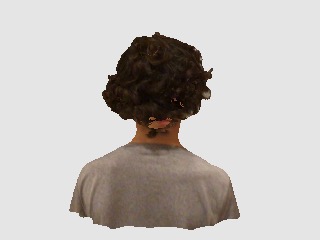
After some practice, I got the hang of it and was able to capture both of my children without any model errors. Here’s a model of my daughter.
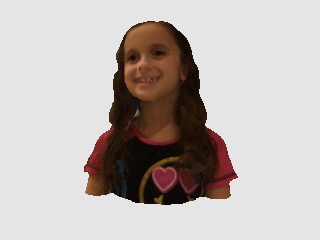
You can view the full model here. The models import into the Windows 10, 3d builder in the wrong orientation and with an error, but the orientation can be rotated and the error is fixed by the program.
Canvas
Canvas is another app for the Structure Sensor. This app is designed to render a room in 3D and has an option to have the 3D scan converted into a CAD (computer-aided design) file so that architects and builders can use the captured measurements as a starting point for modification.
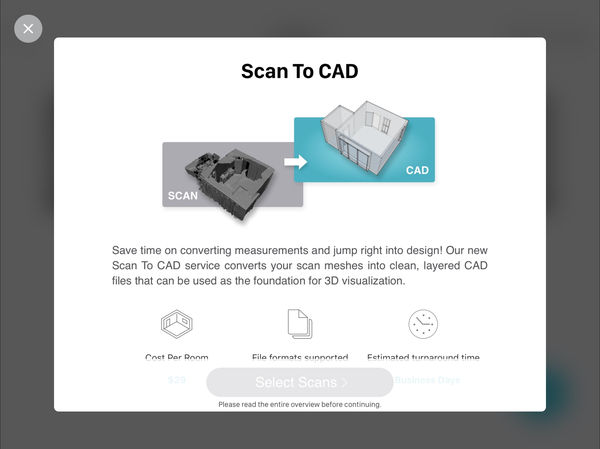
I decided to model a downstairs hallway in my house that has a number of doors and a coat rack area in order to test the capabilities of the device. I had some guidelines to go on but since the time I have made the renderings and now, a video on the scanning process has been published by Occipital. The video below gives an impression of what it is like to use the software.
Once some familiarity is gained with using the software, the whole process is quite fun. The software indicates the rendering of the space by apparently covering it in a white foam. The end result is that the entire scanned area looks like it is covered in shaving cream or marshmallow.
Here are some pictures and screenshots that I made of the capturing process.
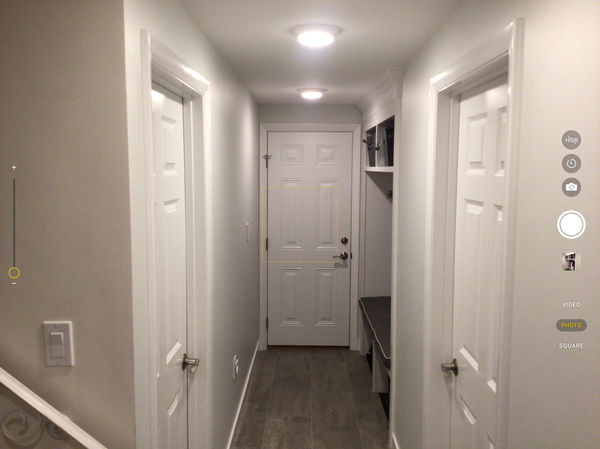
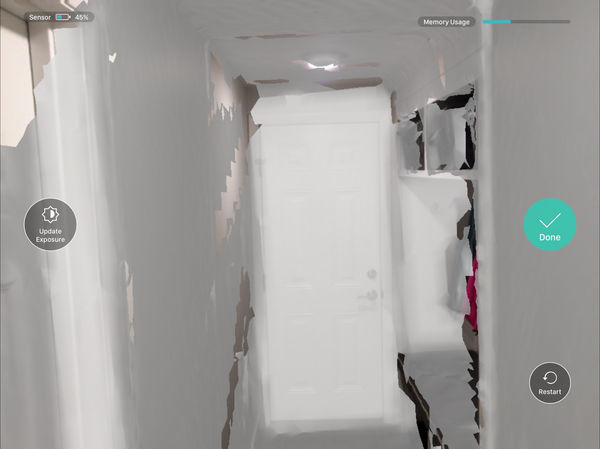
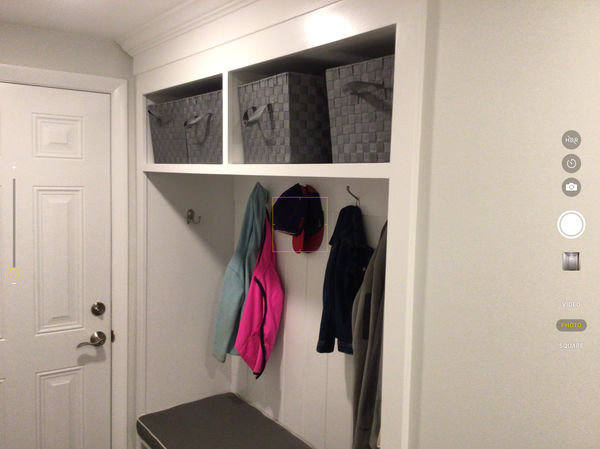
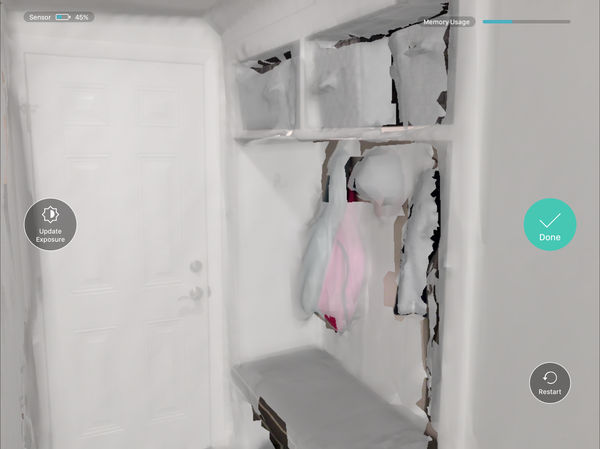
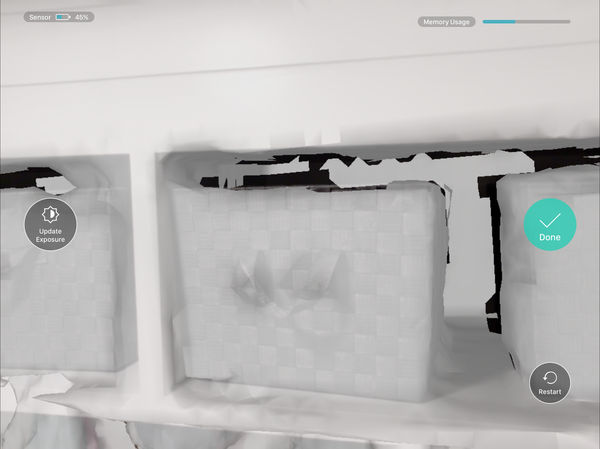
This shows a screenshot of the other end of the hallway.

Instead of showing the camera image, it is possible to show the image depth view rendered in false color
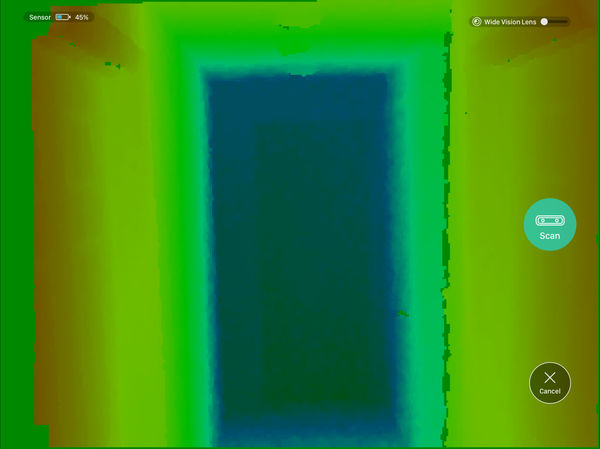
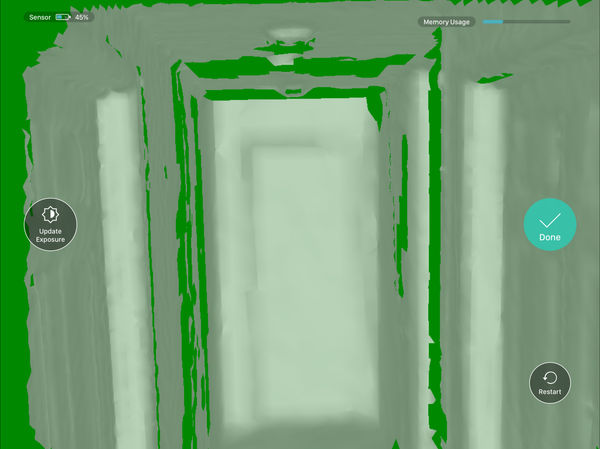
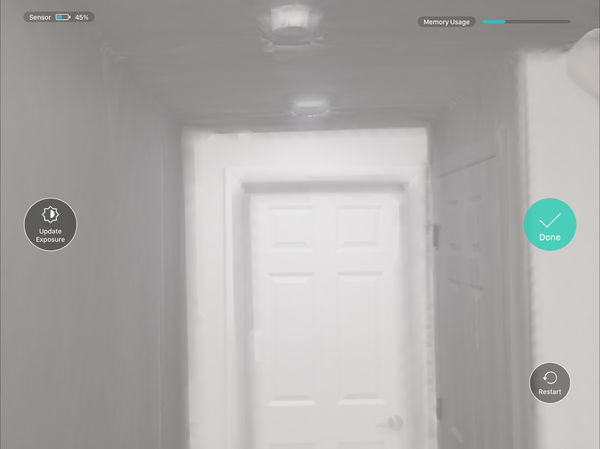
The model files I made include the stairwell going upstairs.
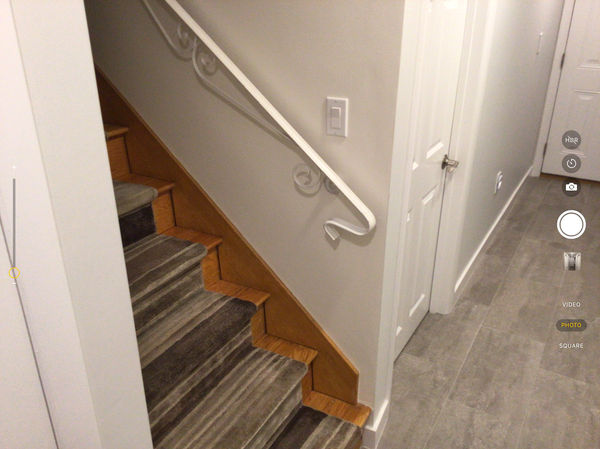
Here is a view of the stairs from the opposite angle.
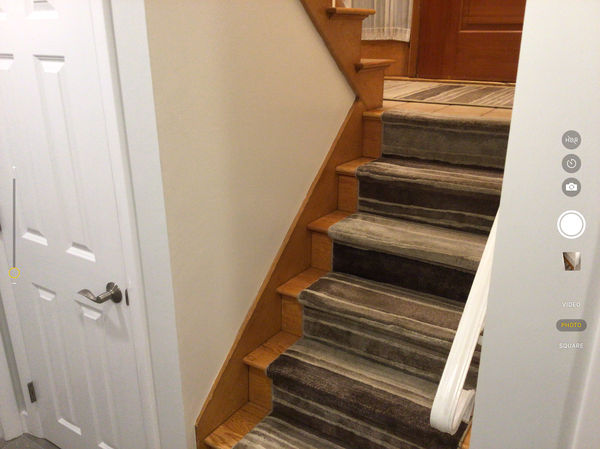
This is my best rendering. The remainder of the attempts below have some shortcomings. Some, like the capture with an incomplete floor, would be fine for conversion into a CAD model.
Like the Scanner app, the models import into the Windows 10, 3d builder in the wrong orientation and with an error, but the orientation can be rotated and the error is fixed by the program. CloudCompare is a good cross-platform alternative, has a portable build, and doesn’t have any importing issues.
What I like
- Unique device
- Powerful features
- Open development
What needs to be improved
- Learning curve
- Cost
- The adhesive bracket may limit camera use
- The camera cannot be used with a case
Final thoughts
With the Structure Sensor, a whole new dimension can be experienced with your iPad.
Price: $379 to $499
Where to buy: Structure
Source: The sample for this review was provided by my employer.



Gadgeteer Comment Policy - Please read before commenting
Structure Sensor is a powerful 3D scan. The best value market price. To optimize your business using, it must be connected to a custom application. For that, I recommend you to go through an application development agency, which knows this product and its specificities: as Sidekick Interactive. https://www.sidekickinteractive.com
Hold on, this is waiting to be approved by Electropages.
3D scanners on iPad have already proven themselves. The startup Occipital has already done a very good job with the Structure Sensor and the manufacturing processes of some manufacturers have been revolutionized with just an easy-to-use application. A simple accessory can save a lot of time, improve efficiency and precision!
Here is an interesting project thanks to Occipital 3D scanners on iPad: https://www.sidekickinteractive.com/portfolio/you-mawo-3d-scanner-app-by-occipital-structure-sensor/
We are glad to work with this company, we innovate every time.
I think you need to mention that they do not accept returns on this camera. That seems like a red flag to me.
Occipital recently announced a new scanner in their portfolio, the Mark2. We have tested it with no particular added value from what we found out. The bad news: they say that the first version will progressively within one year not be usable anymore, all the people who bought one can throw in in the garbage. They should buy the new one…..and probably throw it in the garbage again when they will come out with a version 3?
What a greedy way to make business, shame on that company!
One of those unfortunate realities of some gadgets is that their continued use and development is tied to corporate profits. It is a shame when companies take advantage of planned obsolescence to realize their profit margins.
The structure scanner does a decent job for its price. My company used it for three years now with good results (medical devices). Apparently they have now communicated that they will no longer provide updates for these, we’ll need to buy a new one. Hard to swallow!
Not the kind of company that deserves respect.